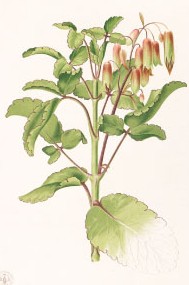Copious Kalanchoe
By Audrey Stallsmith

And they blessed Rebekah, and said unto her, Thou art our sister, be thou the mother of thousands. . .and let thy seed possess the gate of those which hate them.
Genesis 24:60
Many houseplant books recommend tossing kalanchoe plants after they finish flowering, as they are hard to bring into bloom again. But, me being one of those people who never toss anything but salads, I feel quite smug to see that my kalanchoes from last year are making new buds.
Of course, I must admit to reading somewhere that the plants need short days to flower. So I put them under my grow-lights in the basement, which are programmed to run only twelve hours per day during the winter. As a result, I can't really claim that the buds are due to my green thumb, as much as to my propensity for reading everything within reach!
In fact, you don't really need a green thumb to grow kalanchoes. Being succulents, plants that store water in their leaves like cacti, they thrive on neglect. As proved by the popularity of the Mother of Thousands or Devil's Backbone plant, which may have derived its name from the scripture above. Native to Madagascar, it is actually Kalanchoe daigremontiana. And, as is true of most cacti and succulents, it is more likely to die from over-watering than under-watering.
People are fascinated by the fact that this kalanchoe produces small plantlets along the edges of its leaves. So, like Goethe--who was reportedly fond of doing so--you can gift "baby backbones" to all of your friends. Though, judging from some complaints I've seen from people in more tropical climes, this prolific reproduction is not universally admired. In fact, the plants too may--as the scripture goes--often "possess the gate of those which hate them!"
According to San Marcos Growers, "kalanchoe" may derive from "a phonetic transcription of the Chinese words Kalan Chauhuy, meaning "that which falls and grows." Kalanchoe pinnata, which is the only type native to South America, also "drops" its young. Fortunately it is popular there, as a treatment for infections, inflammations, asthma, and etc.
It is often made into a tea by soaking crushed leaves in water overnight. Please only apply that "tea" externally, however, as some kalanchoes contain toxins which render them poisonous. They and their kin are considered the cause of "shrinking disease," which affects livestock in Africa and Australia. So it's probably best to keep them out of reach of small children and pets.
A German seed merchant named Robert Blossfeld introduced the kalanchoe as a house plant in the 1920's. A popular variety, blossfeldiana is named for him. I recall that one of my own kalanchoes has double flowers, so I would guess it is one of the new Calendiva types that derive from blossfeldiana. (I have a bad habit of buying plants after they are marked down at Wal-Mart, when they are often missing their labels!) I suspect that kalanchoe would be very easy to strike cuttings from, as it is already sending out roots from its joints.
Two other kalanchoes of special interest are beharensis (AKA Elephant Ear or Felt Bush), the tallest of the family which can reach twelve feet, and tomentosa (AKA Panda Plant, Chocolate Soldier, or Pussy Ears), which has furry silver leaves with brown markings.
Kalanchoes have had a wide variety of nicknames applied to them, including air plant, cathedral bells, clapper bush, flaming Katy, floppers, life leaf, live forever, Mexican love plant, and miracle leaf. And part of the miracle may be that these tough plants can make even the most negligent gardener look good!
Kalanchoe pinnata image is from Flora de Filipinas by Francisco Manuel Blanco.








